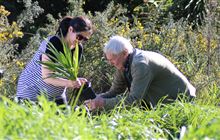New strategy to ensure nature thrives
Archived content: This media release was accurate on the date of publication.
Introduction
The Minister of Conservation Eugenie Sage today launched Te Mana o te Taiao, the Aotearoa New Zealand Biodiversity Strategy.Date: 10 August 2020 Source: Office of the Minister of Conservation
The Minister of Conservation Eugenie Sage today launched Te Mana o te Taiao, the Aotearoa New Zealand Biodiversity Strategy - a way forward that envisions Aotearoa New Zealand as a place where ecosystems are healthy and resilient, and people embrace the natural world.
“Many of New Zealand’s plants and wildlife species are found nowhere else on Earth. They are ancient and unique – we have giant invertebrates, flightless birds, penguins that live in the forest, trees that can live for over a thousand years, and the smallest dolphin in the world. These creatures and plants have been isolated to the islands and waters of Aotearoa since the days of the dinosaurs” said Eugenie Sage.
“As New Zealanders, we all want to see kiwi in the wild, but wouldn’t it be even better to have them in our backyards? These are sorts of aspirational goals that could become a reality if we work together on this.
“We recognise the value of nature and our obligation to protect it and importantly, to restore the mauri (the living essence) of nature and people” said Eugenie Sage.
“Many of our threatened species, habitats, and ecosystems are found not only on public land, but also on private and Māori owned land. Strengthening the Treaty Partnership between Māori and the Crown, Te Mana o te Taiao will also help to create and support partnerships throughout local government and iwi,” said Local Government Minister Nanaia Mahuta.
“Coming together, sharing and using knowledge, especially mātauranga Māori, will benefit our work to protect and restore nature. Te Mana o te Taiao includes goals that will make the roles and actions of local government clearer and easier;” said Nanaia Mahuta.
“To date human activities to date have largely impacted heavily on nature, especially indigenous plants and wildlife and their habitats – through burning, forest clearance, over fishing, and our introduction of predators such as rats, stoats, possums and hedgehogs;” said Eugenie Sage.
“The new Biodiversity Strategy is a chance to reset our priorities and take action together so that nature thrives for its own sake and as the basis of human wellbeing.
“The Strategy sets out five core outcomes to ensure nature is thriving by 2050. There are three key themes; getting the system right, empowering action, and protecting and restoring; with specific objectives and goals for 2025, 2030, and 2050” said Eugenie Sage.
The Strategy anticipates a future where caring for nature is part of everyone’s values and an integral part of daily life. The Department of Conservation (DOC) consulted widely to develop it.
“The Aotearoa New Zealand Biodiversity Strategy is about making a collective difference to the health of nature by planning together and agreeing on a way forward,” said Eugenie Sage.
The next steps are to develop an action plan working closely with Treaty partners and local government and landholders as key agents for biodiversity work on the ground.
This strategy links to projects such as Predator Free New Zealand by 2050. It endorses community action like backyard trapping, restoration and revegetation projects.
Background information
As well as public consultation phase in 2019, three key reference groups helped develop the new strategy.
The Te Ao Māori Reference Group was responsible for getting a Māori world view to form the basis of the strategy structure.
The Stakeholder Reference Group consisted of a range of stakeholder organisations involved in biodiversity protection and environmental sustainability.
- Forest and Bird
- Federated Farmers
- Environmental Defence Society
- Forest Owners Association
- Fish and Game
- Fisheries Inshore NZ
The Science Reference Group provided information that underpins many of the key decisions about the way forward for prioritising the recovery of biodiversity.
DOC has developed a companion technical document that describes the status and trend of biodiversity to help set priorities for the recovery of our most threatened species and ecosystems.

